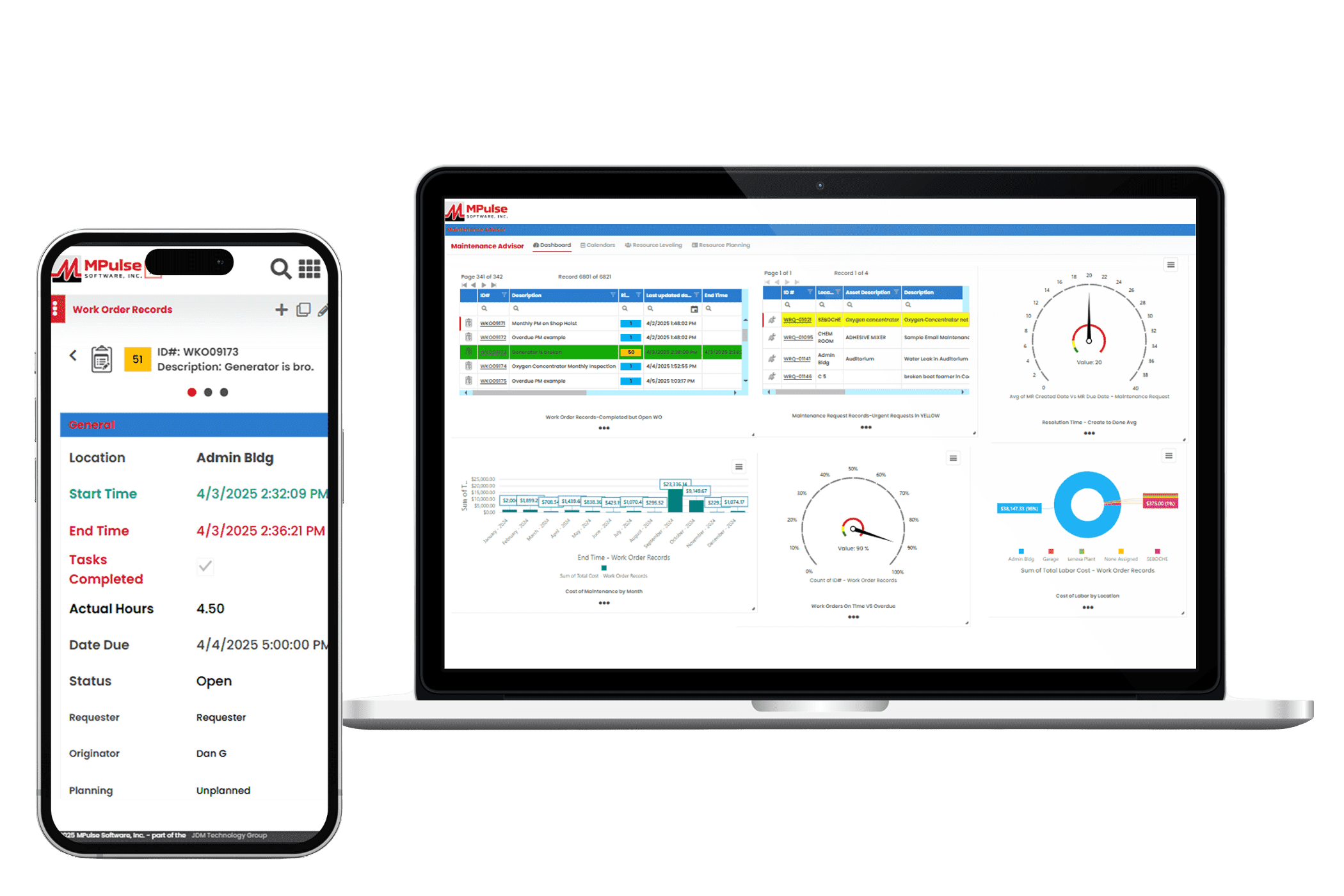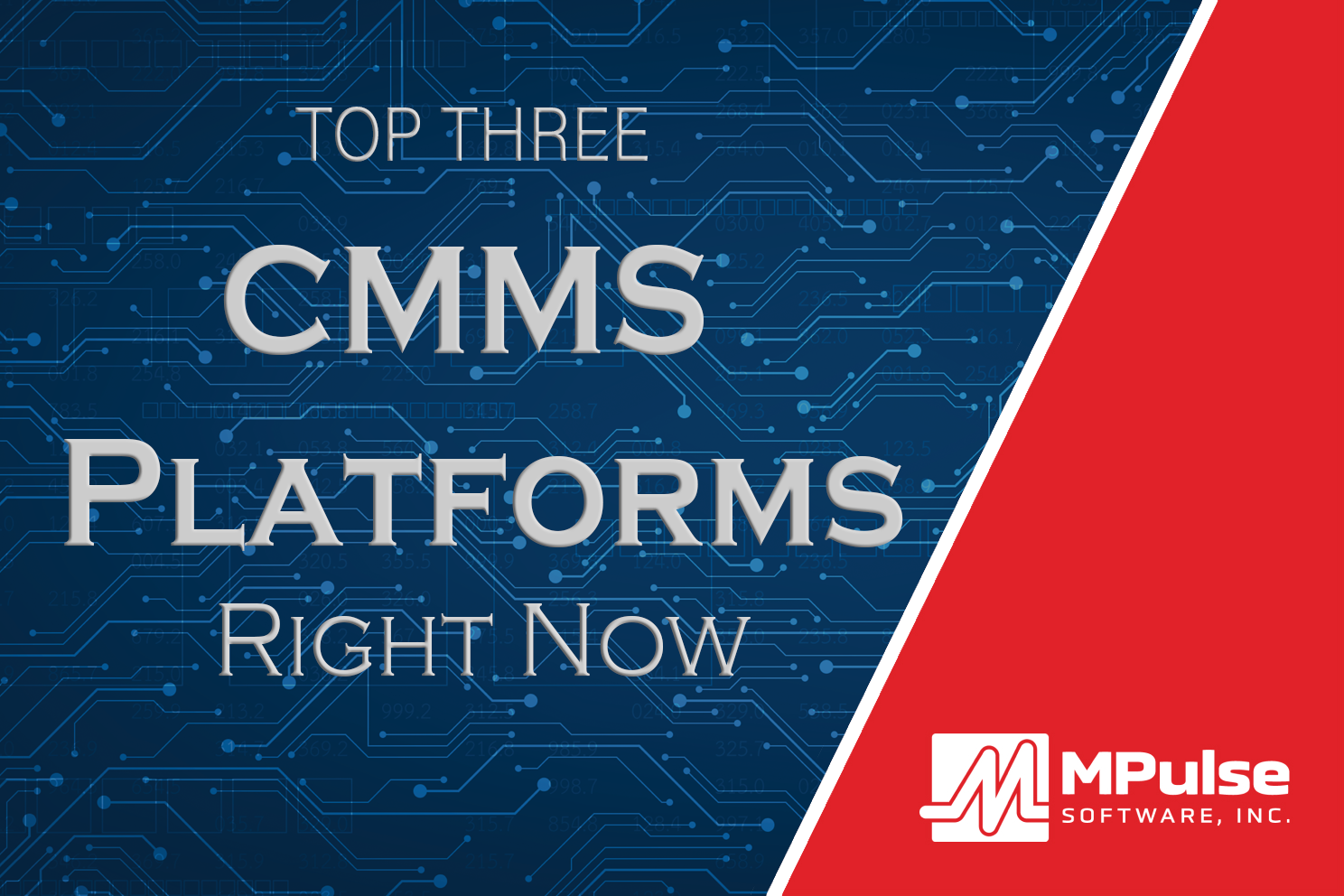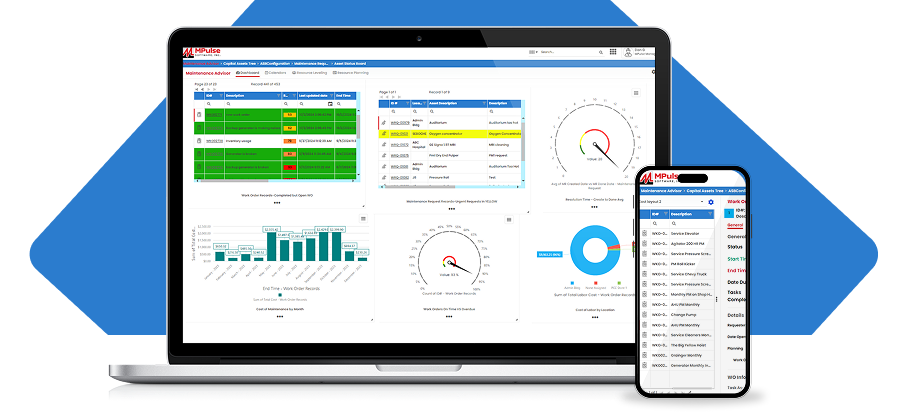CMMS helps maintenance teams plan, track, and improve their operations. It handles everything from preventive maintenance scheduling and work orders to inventory tracking and performance reporting. As a result, your maintenance operations can get tasks done efficiently and easily measure the results.
Most quality CMMS platforms include core features like work order management, maintenance scheduling, asset tracking, inventory control, reporting, and mobile access. These tools help teams prevent breakdowns, eliminate backlogs, manage parts, and control costs. The ultimate goal is to streamline operations and reduce downtime.
Whether you’re transitioning from spreadsheets or replacing your current system, this in-depth comparison will help you choose the right solution.
Table of Contents
1. MPulse CMMS
Top Features
- Comprehensive asset management: MPulse provides a centralized system for managing detailed asset information, maintenance histories, warranties, and documentation. Users can link assets with work orders, parts, and schedules for full lifecycle visibility.
- Easy Work order management: Easily create, schedule, and track work orders. Automated alerts and maintenance calendars help teams stay ahead of preventive maintenance tasks.
- Preventive and predictive maintenance: Schedule maintenance based on time, usage, or condition data. Integration with IoT and machine monitoring systems supports predictive maintenance initiatives.
- Inventory and purchasing control: Track spare parts and supplies, monitor stock levels, and automate purchasing processes to avoid downtime due to missing components.
- Reporting and dashboards: Generate insightful reports on maintenance KPIs, costs, and performance metrics. Customizable dashboards help visualize data for smarter decision-making.
- Integrations and scalability: MPulse integrates with ERP, accounting, and other business systems to support connected operations and centralized reporting,
Biggest Benefits
MPulse CMMS is designed to help organizations of all sizes streamline their maintenance operations, improve asset reliability, and reduce downtime.
- Known for its flexibility and scalability, MPulse offers configurable tools that fit the needs of a range of industries from manufacturing and utilities to healthcare, education, and government facilities.
- The software can be deployed in the cloud or on-premises, allowing organizations to choose the implementation model that best suits their IT strategy and compliance requirements.
- Concurrent licensing allows multiple users to share a limited number of CMMS licenses, so you only pay for the number of people actively using the system at any given time. This flexible model reduces costs and maximizes accessibility for teams that work in shifts or have varying usage needs.
What Do Users Like About MPulse?
Users highlight MPulse’s balance between functionality and user-friendliness. The system’s adaptability to different industries and strong reporting tools make it a favorite for organizations seeking both flexibility and depth in their CMMS solution. Many recommend purchasing one of MPulse’s affordable implementation services to streamline the process even further.
“MPulse has been instrumental in helping us transition from reactive maintenance to a proactive approach. The scheduling and tracking tools are excellent, and the reporting gives us clear visibility into our maintenance costs.” – James K. on Capterra
“What I appreciate most is that MPulse can grow with your organization. It’s easy to start small and add modules or integrations as your needs expand. The support team is also responsive and knowledgeable.” – Verified User in Manufacturing on G2
“MPulse makes it easy to organize maintenance work and asset data. The ability to customize fields and workflows means we can tailor the software to fit how we operate instead of the other way around.” – Sarah M. on G2
Pricing
MPulse offers flexible pricing tiers depending on deployment type (cloud or on-premises), number of users, and selected modules. Plans generally start around $49 per user per month, with additional costs for advanced features like predictive maintenance, API access, and enterprise reporting. A free demo and custom quote are available upon request.
2. Limble CMMS
Limble CMMS is a cloud-based platform that helps organizations manage and improve their maintenance operations. With an solid interface and a range of practical features, it supports teams across industries in organizing workflows, reducing downtime, and maintaining asset performance.
Top Features
- CMMS tools: Provides a complete set of integrated tools for full lifecycle asset management and maintenance. Connects with other organizational software platforms.
- Work order management: Create, prioritize, assign, and track work orders with a drag-and-drop interface while enabling mobile access for real-time updates and improving communication between maintenance teams and other departments.
- Preventive maintenance: Schedule recurring tasks based on time, meter readings, or custom triggers, automate reminders to ensure on-time maintenance, and reduce downtime while extending asset lifespan.
- Asset tracking and management: Maintain a centralized database with asset details, maintenance history, and related documents while monitoring performance, detecting issues early, and optimizing asset lifecycles.
- Reporting and analytics: Generate reports to track maintenance metrics and identify trends while using customizable dashboards for a visual overview of operations and ongoing improvement
- Integrations: Connect with ERP systems, accounting tools, and IoT sensors.
Why Users Like Limble CMMS
Companies like G2, Capterra, Reddit, Software Advice, and more make it easy to hear from software users about their experience. Here are some of the most useful reviews.
- “I’ve tried several CMMS platforms over the years, and Limble stands out as one of the most user-friendly and efficient solutions.” – Jared B. on Capterra
- My techs are MUCH better about tracking work orders and entering their information and hours worked. The app is also developed by Limble, so it’s a pretty seamless transition between the site and the app.” – Anonymous Verified User on G2
- “Our biggest issue with Limble is that we don’t maximize our utilization of all of its capabilities. Implementation was smooth, but we only utilize a small percentage of the program.” – Nathan G. on Capterra
What Do Users Dislike About Limble CMMS?
- “It takes a while to get used to how everything works and remembering how to get to certain places but over all it’s more on the user.” – Nathan G. on Capterra
- “I think its made by software people that has little experience in maintenance. As such the system does not support anything regarding planning and scheduling of work orders. Work orders do not have different status’, you cannot have different dates for when orders are planned, kitted, due etc., you cannot manage/schedule work in any smart way (yes, they have an overview, but nothing that works). It is basically a solid platform for capturing new work requests and also closing out work. But anything in between (the planning and scheduling of work) will need to be done outside the system. They need to hire some folks from the real world (not software people) that understands maintenance and then build the system out for planning and scheduling.” – Mads J. on Capterra
3. Fiix CMMS
Fiix CMMS is a cloud-based maintenance management platform that integrates AI and machine learning for maintenance efficiency and asset performance. Its interface and scalable design make it a strong choice for small to mid-sized businesses with distributed assets.
Top Features
- AI-driven reporting: Fiix promotes the use of AI in its reporting features for the analysis of maintenance metrics and machine data.
- Work order management: Allow requesters to submit work orders and track, assign, and manage them from the application.
- Connected shop floor: Integrations with existing business systems and IoT devices collect additional asset data.
- Sustainable practices: Track energy consumption and waste to support sustainability and environmental goals.
- Mobile-first application: Technicians can use the system on mobile devices, giving teams access to work orders, asset information, and maintenance history from anywhere.
What Do Users Like About Fiix?
Users report that overall, Fiix is a useful tool for helping organize and execute maintenance and equipment servicing. They also report a good relationship with customer service and overall improved work order coordination across teams.
- “Since the start of using this program, all of our equipment is being serviced in a timely manner, parts inventory has been easy to maintain, and any information for that equipment is always easy to access. For example: manufacturer, model and serial number. Overall, this program has made my maintenance program easy and simple to use and track.” – Qasim M. on Capterra
- “Fiix makes it easy to include important details for work orders. Things like photos, relevant parts needed for the machine, specific task lists for the machine, etc. The program has a lot of useful features that help technicians communicate as they work on the same work orders together. Also, being very easy to use on a phone or tablet is a huge plus.” – Kyle G. on G2
What Do Users Dislike About Fiix?
Reviewers note that there is room for improvement in the way the system facilitates communications with work requestors who don’t have user licenses. They also comment on the lack of customizability for some features.
- “We have a lot of guest users that log service tickets and it would be good to have two-way communication between maintenance techs and guest users when a service ticket is being looked at or worked on; it does let them know that the ticket is ‘in progress’ or ‘complete’ but the guest can’t see any other data that the tech writes in the ticket work instructions.” – Paul S. on G2
- “Administrators need more access to make changes to assets and scheduling without having to get ahold of someone to allow the changes to be made. I wish there was an alert on the system to let everyone know that a PM is about to be overdue, instead of letting you know it’s late after the fact.” – Scott J. on Capterra
Pricing
Fiix CMMS uses a tiered pricing structure, beginning with a free plan that covers essential maintenance functions, then expanding to paid tiers with more advanced capabilities. The Basic plan costs $45 per user per month, and the Professional plan is $75, both adding tools such as advanced scheduling, analytics, and reporting. For larger organizations with specialized needs, the Enterprise plan provides customized solutions with pricing available upon request.
4. UpKeep
UpKeep positions itself as a mobile-first CMMS built to simplify maintenance and operations management for businesses of all sizes. Its interface and features enable users to manage work orders, track assets, and streamline maintenance activities from both mobile devices and desktops.
Top Features
- Mobile-first functionality: Upkeep promotes its mobile app to help teams access and manage work orders, capture data, and communicate from any location.
- Work order management: Create, assign, and track work orders with barcode scanning, image attachments, and digital signatures.
- Preventive maintenance scheduling: Schedule recurring maintenance tasks based on time, meter readings, or custom triggers with automated reminders and notifications.
- Inventory management: Track spare parts, tools, and other resources to oversee parts inventory availability.
- Reporting and analytics: Generate reports to track maintenance metrics, identify trends, and make data-driven decisions.
What Do Users Like About UpKeep?
UpKeep customers report it to be a significant upgrade from paper and manual processes, especially for the cost. They also appreciate its useability and visual appeal.
- “I love that it does work orders, PM management, and inventory control. Being able to barcode and add photos of equipment is awesome. Maintenance, Production, Sanitation, and Quality all use this software. Creating work order notification takes less than 30 seconds. So much better than paper!”– Stephanie W. on G2
- “Work orders have been so easy with the use of the UpKeep application. I like the ability to complete work orders using smartphones and share them with colleagues so that everyone can contribute towards the activities done.” – David O. on Capterra
What Do Users Dislike About UpKeep?
While UpKeep is rated highly overall, some users report a lack of customizability, bugginess, and technical difficulties with some features.
- “We are dealing with a lot of technical issues on a regular basis. The program has not operated without issues since we started using it.” – Chris B. on Capterra
- “The preset layout for the supply list seems to be in gradient descent. The parts I use most often are those with the lowest part number, so I need to reorder the sequence the moment I look at them. Writing down my preference would be an excellent addition. The ability to store our ongoing inventory repertoire is helpful, however, how to load it can be confusing. The guidance in the video was not very specific. Written help would be helpful.” – Gabriela L on Capterra
- “If the system worked properly I would be happy with it. unfortunately at this time the system is frustrating to work with.” – John T. on G2
Pricing
UpKeep offers a tiered pricing structure based on the number of users and the level of features needed. They do not offer a long-term free plan but do provide a 14-day free trial. Plans range from a “lite” level that includes basic maintenance management tools at $20 per user per month. Advanced options that include predictive maintenance, reporting analytics, and integrations can cost as much as $120 with additional products and add-ons like IoT connectivity for additional fees.
5. MaintainX
MaintainX is a mobile-first CMMS that emphasizes the advantages of managing maintenance through its mobile app. It offers an interface and tools for handling work orders, performing inspections, and tracking assets from smartphones or tablets. The platform is geared toward organizations with distributed teams and frontline workers who need real-time access to information and tasks while on the move.
Top Features
- Mobile-first design: MaintainX highlights its mobile app to access and manage work orders, conduct inspections, and communicate between team members.
- Work order management: Create, assign, and track work orders using barcode scanning, photo attachments, and digital signatures.
- Preventive maintenance: Schedule recurring maintenance tasks based on time, meter readings, or custom triggers with automated reminders.
- Messaging and collaboration: Team chat features allow sharing of updates, photos, and videos within the app.
- Safety inspections: Checklist features are frequently used for safety inspections and audits.
What Do Users Like About MaintainX?
MaintainX delivers the basics for its users, including an intuitive interface, real-time communication, and efficient work order management. Many report having a more organized and more mobile operation as a result of using the system.
- “User friendly, easy to train new staff. Work order details, including photos. Built-in communication tools. Great filtering options when drilling down on specific data.” – Adam M. on Capterra
- “General ease of use: Extremely mobile friendly and not cumbersome. Incredibly easy to make work orders with a mobile device. Easy to add and edit photos. It was very easy to integrate within a company with multiple locations and no established CMMS System or record-keeping in place.” – Rusty K. on G2
What Do Users Dislike About MaintainX?
Smaller teams or startups may find that MaintainX’s pricing is higher for the features offered than some other solutions. Some users report occasional bugs or limited options for customization and integration with other tools.
- “With the freedom to customize the system to fit your needs it makes it easy to get data entered wrong if you are not careful. More customizable permissions for users would help a great deal.” – Steven P. on G2
- “Having to create the same procedure across multiple Organizations instead of creating one and applying it to all Organizations.” – Brandon B. on Capterra
Pricing
MaintainX provides four pricing tiers, starting with a free basic plan that includes unlimited work orders and messaging. The Essential plan, priced at $16 per user per month, adds features like recurring work orders and reporting. The Premium plan costs $49 per user per month and includes tools such as parts inventory management, purchase orders, and API access. The Enterprise plan offers custom pricing for large organizations, with advanced security, IoT integrations, and dedicated account management.
6. eMaint CMMS
eMaint CMMS, a cloud-based solution from Fluke Reliability, offers a suite of tools for managing maintenance operations. Its features include work order management, parts inventory tracking, and preventive maintenance scheduling. The platform is built to support the asset management requirements of organizations across a wide range of industries.
Top Features
- Work order management: eMaint’s work order feature is designed to manage work orders with automated workflows like routing and escalation procedures.
- Preventive maintenance: Schedule and track preventive maintenance tasks based on various criteria, including time, meter readings, and condition data.
- Asset management: Centralized database of assets, including maintenance history, associated documents, and warranty information.
- Dashboards and reporting: Summarized data on maintenance operations with customizable dashboards and reports.
- Integrations: Capability to connect with existing business systems, such as ERP and inventory management software.
What Do Users Like About eMaint CMMS?
Overall, eMaint users like the useability of the system and its responsiveness to customer requests.
- “We are happy with how work orders flow for the most part. Compared to other top-tier CMMS solutions, eMaint is definitely competitive with their pricing. They are open to suggestions, and they have been very helpful.” – Verified User in Facilities Services on G2
- “Ease of use for scheduling routine preventive maintenance, easy to complete maintenance work orders.” – Christopher K. on Capterra
What Do Users Dislike About eMaint CMMS?
Some user reviews highlighted difficulty navigating the system to complete tasks or find the information they were looking for.
- “It’s a good and bad thing that there are so many paths to get to the same destination, but most users nowadays are more computer literate to figure it out. That was more towards the older generations that like things more simplified when it comes to technology.” – Randy R. on G2
- “There are a few items that we are not overjoyed about. Searching for assets can be a bit of a hassle when it comes to getting the results you are looking for. Our parts area of eMaint took almost a year to get fixed after issues occurred during implementation.” – Verified User in Facilities Services on G2
- “The mobile user interface is not the easiest to use. I feel like the menus should be easier to navigate, and you should be able to use the menu no matter what page you are on (instead of having to go back or go to the home screen again).” – Kathryn N. on Capterra
Pricing
Like many CMMS platforms, eMaint uses a tiered pricing model starting at $69 per user per month. Unlike some other solutions, it also applies additional fees for document and image storage based on usage in MBs or GBs, which could be an important factor for certain organizations.






